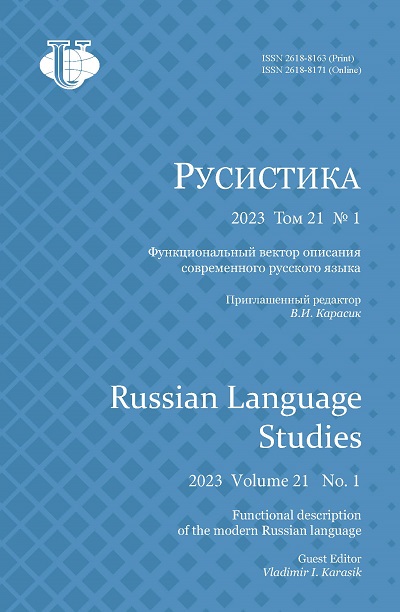The paradigmatics of a compound abbreviation as a means of predicting equivalence relations
- Authors: Terkulov V.I.1
-
Affiliations:
- Donetsk National University
- Issue: Vol 21, No 1 (2023): Functional description of the modern Russian language
- Pages: 79-96
- Section: Key Issues of Russian Language Research
- URL: https://journals.rudn.ru/russian-language-studies/article/view/34142
- DOI: https://doi.org/10.22363/2618-8163-2023-21-1-79-96
- EDN: https://elibrary.ru/ZNQUSE
- ID: 34142
Cite item
Full Text
Abstract
The author describes the methods of finding and predicting compound word correlates in its equivalence nest on the basis of paradigmatic relations between the abbreviation and its decoding stimuli. The relevance of the study is determined by the fact that it established the principles of dictionary entries formation for the Exploratory Dictionary of Russian Word Abbreviations compiled by Exploratory Laboratory of Abbreviation Trends Research at the Russian Language Department of Donetsk National University. The paper gives general idea of the multiple motivation possibilities of abbreviated words in the modern language. The aim of the study is to generally represent the dictionary methods of finding and predicting the content of compound abbreviation equivalence nests. The author considered pure search models in existing dictionaries of abbreviations and texts, where abbreviations and their equivalents are presented as absolute synonyms, as well as extrapolation prediction methods by decoding matrices models of word equivalence nests, connected with the described abbreviations and their decoding stimuli through their paradigmatic relations. The latter led to forming compound abbreviations paradigmatic associations typology, including an abbreviation nest, an abbreviation-onomasiologic field, an abbreviation group and an abbreviation paradigm. The novelty of the study has been determined by the fact that for the first it provides a set of methods for finding and predicting the equivalence nest of abbreviated words; the methodology of the obtained results verification is also described. The results have provided the possibility of a full-fledged comprehensive dictionary description of compound abbreviated appellatives. In the future, the author is planning to develop methods of searching for equivalents of other formal onomasicologic abbreviation types - initial abbreviations and onym compound abbreviations.
Full Text
Table 1. Prediction according to the matrix of the abbreviation field
Word | у-х(adject) | y-x-a(adject) x-processing | y-x-a(adject) x-machining | y-(on)-x2-z2(noun) по переработке х2 | y-(on)-x2-z2(noun) (for) machining x2 |
Petroleum refinery | Oil factory | Oil processing factory | – | Factory on oil processing | – |
Dairy | Milk factory | Milk processing factory | – | Factory on milk processing | Factory for cultivating milk |
Table 2. Prediction according to the matrix of the abbreviation-onomastic field
Word | x-y(qualifier) | y(for)x2 (destinative-instrumentalis) | y(for)x2 (destinativeperson) | (for)x-a2 (transport, destinativeinstrumentalis) | y(for)x-z2 (transport, destinativeinstrumentalis) |
Highway | Motor road | Road for cars | Road for motorists | Road for motor vehicles | Road for automobile transport |
Bikelay | Cycling alley | Road for bicycles | Road for cyclists | – | – |
About the authors
Vyacheslav I. Terkulov
Donetsk National University
Author for correspondence.
Email: terkulov@rambler.ru
ORCID iD: 0000-0002-0418-4260
Doctor of Philology, Professor, Head of the Department of the Russian Language, Philological Faculty
17 Shchorsa St, Donetsk, 83050, Russian FederationReferences
- Akulich, E.A. (2017). Abbreviated group velo-: General characteristics. Moscow University Philology Bulletin, (6), 117–124. (In Russ.)
- Alamayrekh, Ye.Yu. (2020). Model of the decryption and model of the abbreviation formal diversity in the abbreviation group “auto-”. Current Issues in Philology and Pedagogical Linguistics, (2), 91–102. (In Russ.) https://doi.org/10.29025/2079-6021-2020-2-91-102
- Bratcun, D.A. (2018). Abbreviated onomasiological class: Formal description models. Novye Gorizonty Rusistiki, (6), 4–9. (In Russ.)
- Brovets, A.I. (2016). On simultaneous abbroconstructes (on the material of the electro abbreviation group). Russian Language in the Multicultural World: Proceedings of X International Scientific and Practical Conference, (1), 41–52. Simferopol: ARIAL Publ. (In Russ.)
- Brovets, A.I. (2017). The modification interpretive deciphering stimulus of an abbreviated word. Moscow University Philology Bulletin, (6), 98–107. (In Russ.)
- Brovets, A.I. (2019). The deciphering stimulus of a compound word: The problem of definition and description. Russian Language Studies, 17(4), 487–501. (In Russ.) https://doi.org/10.22363/2618-8163-2019-17-4-487-501
- Krestyaninova, E.S. (2018). Textual equivalence of abbreviations included in the abbreviation nest “factory”: Onomasiological class “factory associated with animals”. Russian Language in the Multicultural World: Proceedings of II International Symposium, (2), 237–242. Simferopol: ARIAL Publ. (In Russ.)
- Lyalyuk, A.A. (2017). Onomasiological and field approaches to the study of abbreviory words. Current Issues in Philology and Pedagogical Linguistics, (2), 146–149. (In Russ.)
- Lyalyuk, A.A. (2020). Abbreviation-onomasiological field of “buildings”. [Author’s abstr. cand. ped. diss.]. Donetsk. (In Russ.)
- Mikhailova, E.N. (2017). Оnomasiological models of accordance in abbreviated group “бензо-”. Novye Gorizonty Rusistiki, (2), 42–45. (In Russ.)
- Mikhailova, E.N. (2018). Model forecasting relative decryptal stimulus. Novye Gorizonty Rusistiki, (6), 74–80. (In Russ.)
- Riazanova, V.A. (2020). Typology of abbreviated groups: Principles and implementation. Bulletin of Donetsk National University. Series D: Philology and Psychology, (1), 114–122. (In Russ.)
- Ryazanova, V.A. (2018). Methods for predicting equivalence relations in hybrid groups. Novye Gorizonty Rusistiki, (6), 44–49. (In Russ.)
- Ryazanova, V.A. (2019). Decryption stimulus as a source of interpretation of a complex word. Socio-Cultural Environment of the University and the Language Development of the Personality of a Foreign Student: Proceedings of the Scientific and Practical Conference (pp. 84–88). Moscow: RGU imeni A.N. Kosygina Publ. (In Russ.)
- Shtelman, T.A. (2022). The compound-abbreviated name as a formal onomasiological type of abbreviations. Novye Gorizonty Rusistiki, (18), 58–63. (In Russ.)
- Terkulov, V.I. (2018). Method for forecasting of equivalency relations for compound shortenings. Linguistic Research and Their Using in the Practice of Teaching Russian and Foreign Languages: Reports of the I International Scientific and Methodological Conference (pp. 69–79). Donetsk: DonNTU Publ. (In Russ.)
- Terkulov, V.I. (2020). Abbreviated appelatives as independent modifications of abbreviations. Russian Language Studies, 18(1), 97–112. (In Russ.) http://doi.org/10.22363/2618-8163-2020-18-1-97-112
- Terkulov, V.I., & Krestyaninova, E.S. (2018). Hierarchy of deciphering stimuli in the nest of equivalence: To the Formulation of the Problem. Novye Gorizonty Rusistiki, (4), 27–33. (In Russ.)
- Zelenin, A.V. (2005). Disabbreviation in Russian. Voprosy Yazykoznaniya, (1), 78–97. (In Russ.)
Supplementary files














